My review of the updated version of one of the greatest adventures of Warhammer Fantasy Roleplay concludes. (Part 1 is here).
So far our Heroes have journeyed up and down the Reikland, hopefully thwarted the schemes of the Red Crown cult, and finally discovered that the warpstone meteorite was taken by Dagmar von Wittgenstein to his home, so it is time to brave…
The Horrors of Castle Wittgenstein
This has always been perhaps my favourite part of any WFRP adventure, and the new 4th Edition version holds up admirably. Arriving by the castle, the PCs first encounter the cursed village of Wittgendorf, and the level of detail here is incredibly impressive. There’s a nice map, and details of a few key locations; there are profiles for key NPCs, including the very entertaining physician, Jean Rosseaux; and there is a timeline of events at the village from the PCs’ arrival. This serves to introduce the castle guards and potentially the chief antagonist, Lady Magritte, as well as hinting at the corruption of the nobility in the castle, and demonstrating the impact on the benighted villagers.
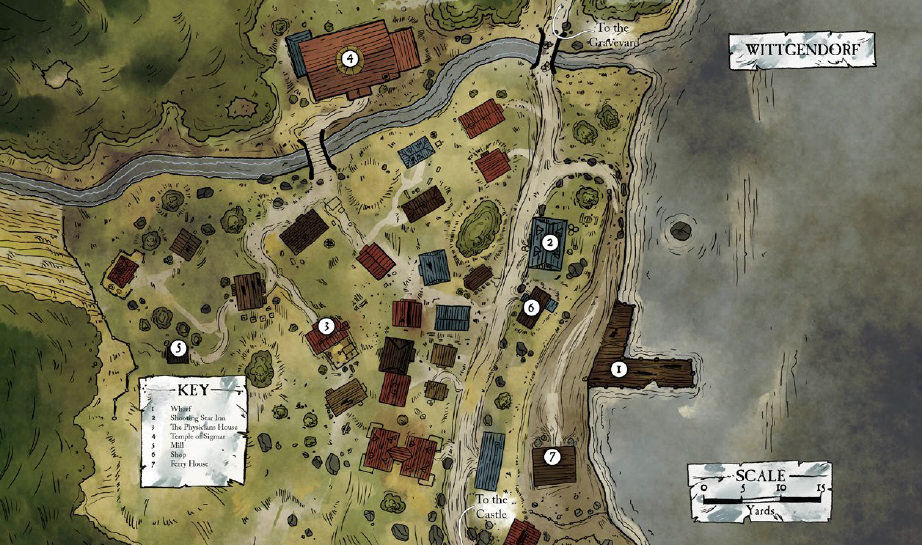
The idea here is that the PCs spend a few days in the village and end up impressing one of the villagers who is a spy for the local Outlaw band by intervening to stop the guards from murdering an old man. They are then taken to the Outlaw camp where they can gain help in assaulting the castle. Along the way, they also have the opportunity to have dinner with Rosseaux and Lady Magritte – potentially gaining some valuable intelligence – as well as tangling with the village’s cannibals, gaining information on the history of the village and castle, and uncovering the reason for the mutations running rife in the village. Pleasingly, all of this is optional – the PCs don’t have to any of it – although the adventure does have an issue that it doesn’t really provide any good options for a clear route forward if the PCs fail to impress the outlaws’ spy. Nevertheless I really like Wittgendorf – it drips with a sinister character and does a great job of hinting at the horrors the PCs are going to encounter soon. I love Rosseaux, who makes a very believable patsy.
Sadly the outlaws camp is disappointing by comparison. There’s no map of the camp, nor a map of the area showing where it is situated in relation to Wittgendorf or the Castle. And we could have done with a few more paragraphs explaining how the outlaws come to help the PCs – one chapter ends with the outlaw chief Sigrid warning the PCs not to go to the castle, while the next starts with a discussion of how the outlaws will aid them in attacking!
In any case Sigrid’s suggestion is that the PCs will reconnoitre the castle alone, before returning to the outlaws to plan an attack. This is a good idea because it encourages the PCs to plan rather than merely charging in with a suicidal assault. They don’t have to do this – there’s nothing to stop them trying to infiltrate the castle without the outlaws help at all – but the adventure clearly expects the PCs to try this approach, and to be fair it is arguably suicidal for 4-6 mid-level adventurers to try to enter a castle protected by dozens of guards and impressive fortifications.
I love the amount of freedom afforded in attacking the castle. There are three ways into the castle – the front gate (basically suicide) and two accessible via a secret tunnel which the PCs will need the outlaws to guide them to. Oddly enough one of the staircases from the secret tunnel actually leads the PCs into the Inner Bailey, bypassing almost all of the guards; it is tough to find but nevertheless possible, and I’m not completely sure why the writers (of the original adventure) put it in there since it avoids a lot of fun content! Nevertheless I guess its a testament to how open-ended this section is.
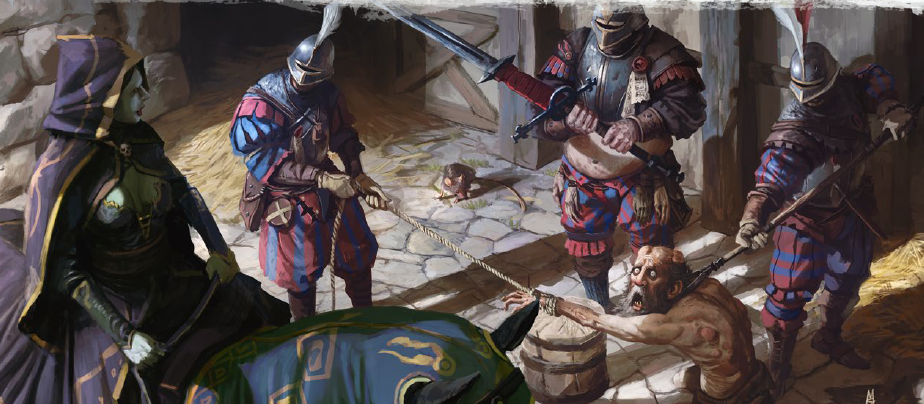
However in spite of the impressive freedom, the layout could be better when it comes to outlining the possible approaches the PCs might take. The adventure does helpfully explain the three potential approaches, but it really could have done with some good referencing as to where these approaches are found! As it is, I had to read the section several times to get a proper handle on what the different possibilities were, and how things are likely to play out with each one of them.
Nevertheless the attack itself has the potential to a truly memorable affair, the PCs acting as infiltrators to open the way for an assault en masse by the Outlaws. The Outer Bailey of the castle is very well fortified – including some very nice authentic touches like the placing of a tower which prevents effective use of a battering ram on the main gates – and we get placement details for a the whole complement of guards, as well as information on how they will react when an attack is detected. There’s no going room to room slaying passive guards – they will take sensible defensive action, though only the sergeants (and troops under their command) will be really proactive. Pleasingly there are also some non-combatants around, so the PCs can pretend to be beggars to do reconnaissance, or even steal (repulsively smelly) guard uniforms to infiltrate this area (though they can’t get all the way into the Inner Bailey in disguise). The GM is advised to run the attack section by simply narrating any combats between guards and outlaws, only rolling dice for the combats directly involving PCs.
Once the dust has settled, the PCs can cross the bridge and enter the Inner Bailey. This is the more “classic dungeon crawl”, with the PCs going from room to room and uncovering all manner of horrors. But the emphasis is far from on a classic D&D-style combat. There are plenty of rooms that are just about the normal functions of a castle – stables, servants’ quarters and guestrooms. There are plenty of encounters with hideous mutants, to be sure, but most are not hostile by default, and many are presented as pitiable rather than genuinely monstrous. The best, and likely most memorable, is Ludwig von Wittgenstein, the philosophical giant cockroach, living in self-imposed isolation in a tower.

But there are plenty of other great locations too – and all of them (with perhaps a single exception) feel like they have a sensible reason to exist in the palatial-but-decaying home of the upper class – but have been twisted by the warpstone beneath the castle. An aviary – filled with weird mutated bird-people. A kitchen garden – housing a hideous huge carnivorous plant. A chapel of Sigmar which has been corrupted for the worship of Slaanesh instead (and, memorably, houses a very weird organ1).
The main house is a particular standout. Assuming they aren’t literally kicking down the door and putting everything to the sword, they’ll be greeted by the senile mutant butler, who will take them for guests and actually lead them to a guest room if they let him (giving them a brief tour of part of the house). The entrance hall itself has a fantastic feature in the family portraits – which over time chart the descent of the family into mutation and madness, starting around the time the warpstone arrived.
Most of the actual von Wittgenstein family can be found in this house, and they are a interesting bunch too. The son is a creepy taxidermist; the mother is a Crazy Cat Lady (complete with mutated cats and hunting trophies on the walls which include an Imperial Tax Collector and a Roadwarden); and the daughter – Lady Margritte, who the PCs might have met in the village of Wittgendorf earlier – a creepy necromancer using warpstone to advance her research into creating unnatural life. (More on her below.)
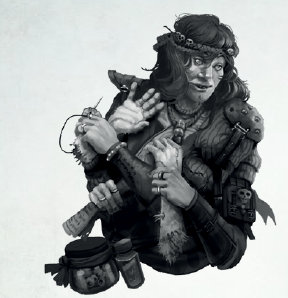
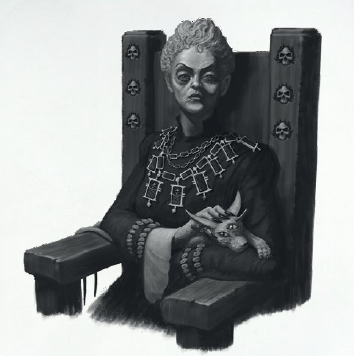
Also in the tower are a couple of guests – the Chaos Warrior Ulfhednar the Destroyer and his Beastman companion, on a diplomatic mission hoping to convince the Wittgensteins to let him use the castle as a base for training his warband and strike out at the Reikland. He’s currently confused about why a castle full of mutants don’t want to support his war against the Empire, and is considering trying to depose Lady Ingrid (the de facto head of the Wittgenstein family). I love his inclusion because he’s a genuine third party: he might just be another combat for the PCs, but if they take the trouble to talk to him, they might actually find a temporary ally. (He is also a very obvious ally for the Red Crown cultists, so if Etelka Herzen managed to survive earlier, Ulfhednar could potentially join forces with her instead, adding a really interesting additional faction to this part of the adventure!)
Back to Lady Magritte: she is essentially the adventure’s Final Boss. As written the PCs will unavoidably happen upon her in her tower laboratory at the climax of her ritual to bring to life a created creature “The Wittgenstein Monster” – a Frankenstein’s Monster expy – as a storm rages overhead. It’s a bit of a contrivence (no matter how long the PCs take investigating the castle, they’ll arrive at this point) but a dramatic one. My main concern here is that I think the author over-estimates the survivability of his villains. I’m no expert in 4th Edition combat, but I don’t think this will be an impressive fight. As written the monster does nothing for the first 3 rounds of combat, during which the PCs’ only adversary is Lady Magritte – a solitary mid-level wizard who will probably die in the first or second round of combat (quite possibly without successfully casting a single spell). The monster is more of a beast, but it still suffers from the usual problem action economy problem of solitary monsters (i.e. a group of PCs will get to attack it multiple times for every time it can attack them). If I were playing, I would recommend adding some servants or low-level undead to stop PCs from simply piling on the necromancer.
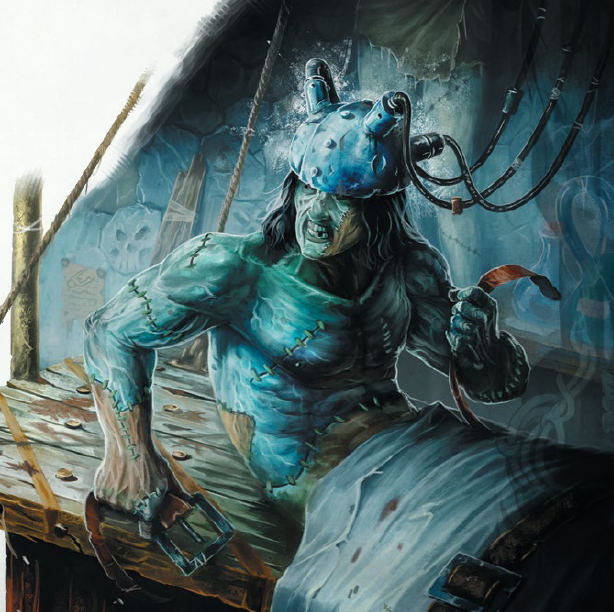
Lady Magritte’s tower also provides written material which can fill in any gaps in the PCs’ knowledge about how the warpstone ended up at the castle, as well as a letter from the missing Wittgenstein brother, Gotthard, who appear to the up to no good in Middenheim – thus providing the PCs with another reason to travel there for the next adventure in the campaign. (Incidentally Ludwig von Wittgenstein, mentioned earlier, can apparently provide information on Gotthard… but the adventure gives no indication of what that info is!)
So with all that done, the PCs need to descend to the cellars where the warpstone is stored. One of the odder facts about the adventure is that the PCs could conceivably find the warpstone without actually exploring most of the castle – since the dungeons are accessible both from the main hall and from one of the secret entrances (as mentioned earlier). In fact, it is potentially possible for the PCs to come up the secret entrance into the Inner Bailey, find a nearby secret door, and happen upon the warpstone immediately – without entering ANY of the castle at all! To avoid this happening, the GM is directed not to allow the PCs to find the secret door at this stage.
Unfortunately as far as I’m aware, there is actually nothing anywhere in the castle that points to the location of the warpstone – the PCs just need to turn over every stone to find it. That means that if the PCs have already passed the secret door’s location then there’s really no reason they should ever discover it – since they’ll consider they’ve already checked there! I think it would be wise to have a note in Magritte’s library indicating where it is stored – although Magritte could also bargain the location for her life if circumstances allow.
In any case the PCs are fated to arrive too late to recover the warpstone – finding that the Skaven (who they encountered in the Barren Hills earlier) have beaten them to it, and are escaping down a corridor before detonating charges which bring down the entire castle while the PCs stage a dramatic escape. It’s certainly a dramatic conclusion to this section, although it does smack a little of deux ex machina. I’ve always found it to be a little disappointing.
But Death on the Reik is not quite finished yet…
After the Castle
The final chapter is a puzzle to me. It’s the one section of the adventure completely unfamiliar to me since it didn’t feature in the 1st Edition version I own. I believe it is adapted from the first part of ‘Carrion Up the Reik’, a marvellously-titled segment in Hogshead’s version of the Enemy Within campaign intended to bridge the rather substantial gap between the original ending of Death on the Reik (the destruction of Castle Wittgenstein) and the beginning of Power Behind the Throne (the PCs arriving in Middenheim, hundreds of miles north). At the time, there was evidence that players tended to get very attached to their barge, making the prospect of abandoning it for the overland journey to Middenheim less than attractive – and therefore potentially derailing the whole campaign.
James Wallis’ solution, famously, was to burn the PCs’ barge. This is now enshrined in WFRP meta-lore (including a player’s online rant about the unfairness of this, and Wallis’ unrepentant reply, both available online, as well as references in the WFRP 4e Rulebook, among other places).
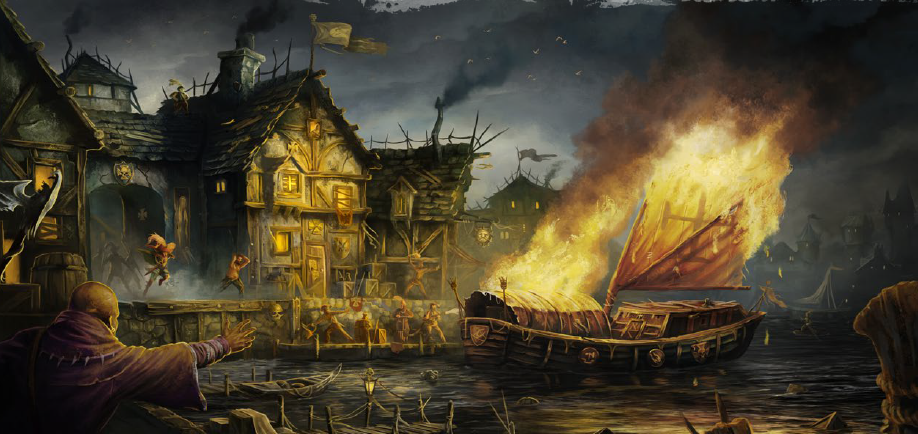
Is it a good solution? I’m not really sure. It certainly feels mean, but you could argue that that is entirely in keeping with the tone of WFRP.
I can confirm however that, in this version at least, it is definitely drawn out. This final chapter is 14 pages long and consists of an extremely long-winded plot by a merchant – apparently in the pay of the Purple Hand – to separate the PCs from their barge before putting it to the torch. This involves a “chance meeting”, a contract (to ferry goods to Marienburg), social interaction at an inn, and social interaction at a dinner party before finally the barge goes up in flames. In virtually all of it, the PCs are basically passive observers – there just isn’t much for them to DO here. Paragraphs are spent addressing the various points at which PCs might object to elements of the plot (e.g. a whole page on the possibility that the players might not like to leave a bunch of stevedores to unload their existing cargo to make way for the new cargo).
Don’t get me wrong, in the midst of this there are some fun NPCs, and its all that very grounded, non-supernatural style of WFRP that I appreciate. But it just isn’t very interesting, and its all there to justify one act of vandalism that is very likely to seriously piss off players. In practice the whole chapter might as well be replaced with a bunch of bandits chucking some torches into the barge at night and you’d achieve the same thing.
Oh and finally there’s a whole connection with Councillor Oldenhaller (the merchant is married to his sister) which is elaborated on at great length… even though there is no official 4th edition version of The Oldenhaller Contract in which this NPC appears, so modern players and GMs are unlikely to have any idea who this guy is. It feels like a reference for the sake of it and in my opinion a pointless waste of page space!
Appendix
Finally the book contains an appendix providing a selection of potential trainers for the PCs. These are intended as a narrative method to justify the PCs advancing by spending XPs – and I think they’re particularly appropriate if PCs want to move into a new career or career level. All were present in the original Death on the Reik – with a similar purpose – but were woven into the adventure text. I think it makes sense to collect them here at the end for reference purposes. There’s a nice variety here, all with plenty of personality (one of the consistent strengths of Cubicle 7’s publications is their NPCs). They comprise a Bargemaster (Josef Quartjin, returning from Enemy in Shadows), a Wizard, Physician and Racketeer. Notably there are no warrior-types – although I guess Sigrid the Outlaw Chieftain near Wittgendorf can fill that gap admirably.) I really appreciate this section – for all its flaws, I think the career system from WFRP is one of the things that makes the game world really come alive, and including in-world narrative for character advancement is a really good idea. As an added bonus you can easily repurpose these trainers as patrons for side adventures too.
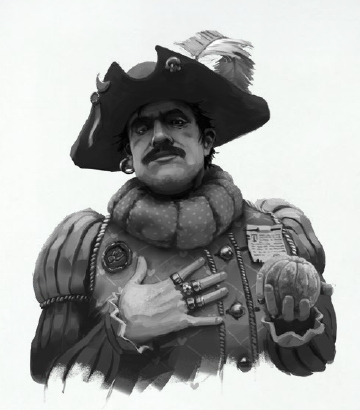
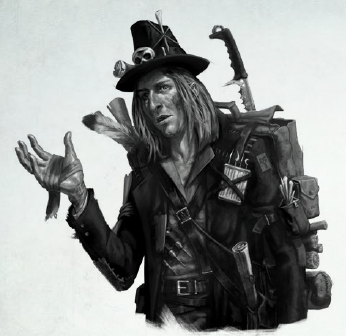
Conclusion
So what do I think of the new Death on the Reik? As with my review of Enemy in Shadows I want to consider it both on its own merits as an adventure, and in terms of how it improves (or fails to improve) on the original.
Death on the Reik has always been one of my very favourite adventures for WFRP – in terms of big, full-fat adventures, it’s a toss-up whether I prefer this or Shadows Over Bogenhafen (or Enemy in Shadows, for 4e). There’s this great feeling of freedom as the PCs ply their way up and down the Reik (even though the plot is actually a pretty clear sequence of stops in a largely predefined order). There are plenty of great locations – the signal tower, the marvellous town of Kemperbad, the awful village of Wittgendorf, and of course the horrors of Castle Wittgenstein – which just ooze character and really bring this early-Renaissance world to life. There are memorable NPCs a-plenty – everyone remembers Ludwig the philosophical cockroach, but there’s loads of others I like, including perfume-laden villain Etelka Herzen, pathetic patsy Rosseaux and haughty Lady Ingrid. There are some dreadful horror scenes (the undead in the signal tower, the mutant in the caves, the horrific charnel pit at the castle) but its leavened with that lovely 1st-edition black humour – not least because of the increasingly bizarre antics of the Purple Hand cult.
Meanwhile the world feels more fleshed out than in Enemy in Shadows, with the marvellous rumours, the mysterious machinations of the Skaven and evidence of the widespread influence of the Purple Hand cult all pointing to how things are happening elsewhere in the Empire while the PCs follow their own quest.
As I made clear above, I absolutely love Castle Wittgentein – some of it is simply horrific, but there’s plenty that foregrounds how the nobility are corrupted in mind where their servants are corrupted in body. It fits in extremely well with the campaign’s central theme of the PCs uncovering hidden corruption at different levels of society. I think almost all the inhabitants of the inner bailey can be dealt with in a non-combat manner and there are many opportunities for interesting roleplay throughout the adventure.
Turning specifically to this edition I feel it’s a bit mixed. On the plus side the artwork is fabulous as usual from Cubicle 7 (I never say enough but this, but its one of the things I appreciate most in their publications) and I appreciate the additional work done on laying out how the movements of the Red Crown are likely to interface with the PCs’ own journey.
One change in the new version (highlighted by Theo Axner in a comment on Part 1 of my review) is that the original adventure was presented in a somewhat sandbox style, whereas this version is presented in a much more linear fashion. I take his point, and have to say that I wish Death in the Reik was a proper sandbox adventure (in fact I’ve written a few thoughts about how you might do this – see my next post), but I don’t think that was ever really the case. Although it was somewhat obscured by the presentation, as Gideon notes in his Enemy Within: A Companion2, the adventure has always had an essentially linear progression: the PCs go from the signal tower to Grissenwald to the Barren Hills and back to the signal tower, before heading to Castle Wittgenstein. Certainly the new version of the adventure is laid out more linearly: for instance, it now specifies where and when the various Purple Hand cultist encounters happen, rather than directing the GM to include the sequence of encounters throughout the PCs’ travels. Ultimately I feel this is a clearer presentation of much the same thing and on the whole I prefer it.
On the other hand I’m disappointed that there aren’t more improvements over the original. I’m particularly disappointed that the adventure hooks aren’t improved – in fact, with the removal of Heironymous Blitzen from the core plot, they’re actually weakened, and the adventure could really do with a a much stronger call to action. The castle assault is still too opaque for the GM – we could have done with a clearer overview of the different options here. And while I like the majority of the maps, I’m very sad about the lack of a scale on the big Reikland map – which is particularly problematic for an adventure where travel times (and thus distances) are important.
And – as noted in detail above – I don’t like the final chapter at all, which feels very long winded for something lacking in anything interesting for the PCs to actually do.
At the end of the day though this is still a fantastic adventure with tons of memorable encounters. I’m less sure than with Enemy in Shadows if this is an improvement on the original – it’s much more of a re-arrangement of the material than an expansion of it. (And naturally if you’re interested in the River Life of the Empire, you now have to buy a separate product – the Death on the Reik Companion – to get that; I’ll review that in due course). I do think it’s a shame that the improvements on the original didn’t go further, but if you don’t own the 1st edition version then I definitely recommend this one.
Buy Death on the Reik from DriveThruRPG here or from Cubicle 7’s site here. The former is an affiliate link so I receive a small payment for purchases made using it.
I also recommend the reviews of Death on the Reik on Awesome Lies and Enemy Within Remixed which are both excellent and comment on some aspects of the book (like the Grognard Boxes) in more detail than I have done here.
Addendum: I’ve also written a short post with some ideas on how you might turn Death on the Reik into a proper sandbox adventure.
- I mean an organ as in the musical instrument, not any other kind of organ, just be clear ↩︎
- Which you absolutely should read if you’re intending to run Death on the Reik – Gideon’s “Enemy Within: A Companion” is written for the 1st Edition version of the adventure, but a lot of the information is relevant to the 4e version too, including lots of useful advice for the GM. ↩︎
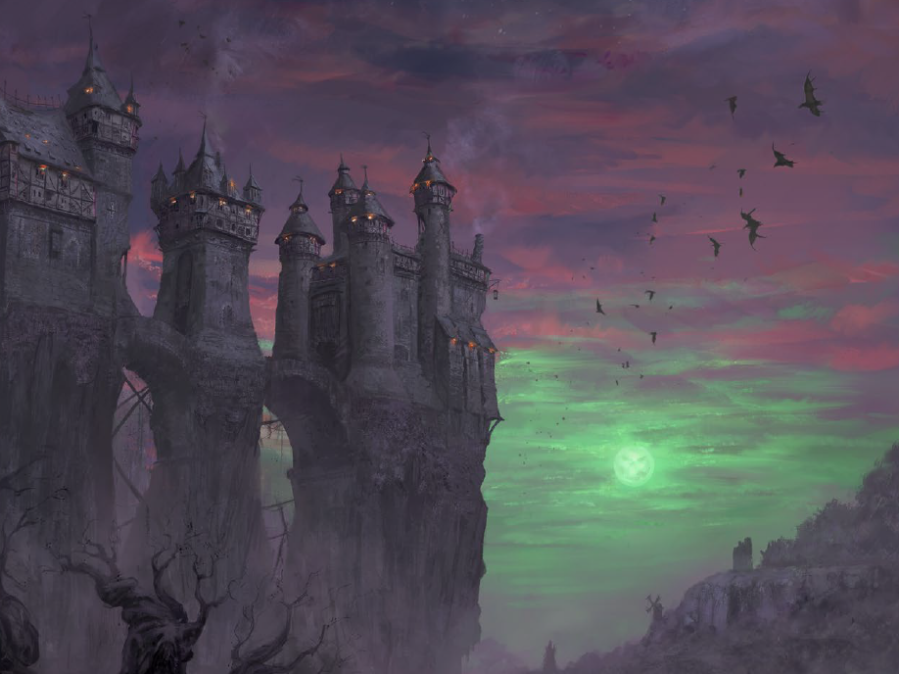
Nice to see the second part so quickly! I’ll probably have to split my thoughts into a few comments (and I’ll try not to repeat my entire review…).
I mostly agree with your assessment of the (original) adventure’s strengths and weaknesses, though it’s no secret I’m more down on the new version – IMO it’s the most disappointing of the five books, and the only one of the three straight rewrites that is decidedly inferior to the original. It has fixed almost none of its well-known flaws and issues, and added a number of new ones. Although given what I’ve since learned of its troubled history this is a bit less surprising (a bit more on that later…).
First minor point:
“And we could have done with a few more paragraphs explaining how the outlaws come to help the PCs – one chapter ends with the outlaw chief Sigrid warning the PCs not to go to the castle, while the next starts with a discussion of how the outlaws will aid them in attacking!”
While this is admittedly a little broad-strokes in the original as well, this is in fact further obscured by the new edition’s habit of making the NPC descriptions shorter and terser (and they weren’t really that long and waffly in the first place). In the original, Sigrid’s writeup (p. 58) – about three times the length of the new one (p. 81) – spells out more clearly that if the PCs are determined to get into the castle, she knows the caves might provide a way in, and if they can scout out such an entrance and let her people in from inside she and her band will be willing to join the assault. It also clarifies that if the PCs scout the tunnels, she expects them to come back and _then_ make a proper plan.
In other words, while the ‘narrative’ text is about the same, in the original the NPC descriptions provide enough guidance for use in the adventure which they don’t always do in the new one.
LikeLiked by 1 person
Thanks – looking forward to reading all your comments! I really appreciated your review (even though I’m not quite so down on the book) and thought you made a lot of good points there.
LikeLiked by 1 person
As I mentioned in a comment on the first part, Andy Law was the main developer of the new TEW at first but left C7 abruptly, apparently on bad terms, around the time Enemy in Shadows was finished and in the first stages of developing Death on the Reik. It’s obvious even to the naked eye that the ambition level of the new TEW dropped sharply at this point, but some comments Law has made later (primarily on his Discord server, Lawhammer) suggest an interesting and IMO plausible explanation to why the new DotR is structured the way it is. Essentially, it seems the first step of developing it was Graeme Davis reorganising the – admittedly sprawling – text of the 1E version into a straight chronological order. Then Law was supposed to rewrite this basic text into a new format – apparently it was intended to be a bit more open and sandbox-y – and presumably also add a lot of new stuff. But before that could happen he jumped ship (as it were), the major rewrite never happened and we were left with this barely updated and chronologically arranged text with, apparently, only some minor further development. This would help explain, among other things, the bafflingly placed epilogue.
TL;DR – the reason the text of the new DotR looks like a half-finished first draft is that it is a half-finished first draft.
This blog post by Gideon talks a bit more about the rewriting of the new DotR after Law’s departure, although it focuses more on the later parts of the campaign. https://awesomeliesblog.wordpress.com/2022/07/25/the-enemy-within-that-wasnt/
LikeLiked by 3 people
Wow that is a fascinating bit of info on the development of DotR, thanks for sharing it.
Reading the comments on Gideon’s post makes me very sad we never got to see this version of the campaign 😦
LikeLiked by 1 person
Since I wrote that post, I’ve learned more about the Law version, but unfortunately I’m not free to share it. I will say that I think we should entertain the hypothesis that the subsequent developers may have had good reason to depart from it, though I don’t know enough to say that for certain.
How has Law’s streamed playthrough developed? Does it contain interesting new ideas?
LikeLiked by 2 people
@Gideon Intriguing! I hope Andy Law is able to talk publicly about it one day. I’d love to know more about how the new campaign was originally going to go, and why it was changed.
I haven’t been following the Lawhammer stream (I’m glad its happening, but listening/watching actual plays isn’t really my thing).
LikeLike
I haven’t kept up with the Lawhammer TEW stream either (last I listened to was just after the end of DotR), but from what I have heard of it, I think it’s fair to say it’s going a bit beyond what I believe he’d have put in the official TEW even with full creative control of it. It’s pretty much the Warhammer Da Vinci Code.
There are certainly interesting and clever ideas here, though personally I’ve found most of them so far from my own creative preferences I’ve found little I’ve wanted to lift directly so far.
LikeLiked by 2 people
So, after my rant in the first part, I found your assessment here at the and, and find I mostly agree!
Wittgendorf and Wittgenstein are great. Suddenly, the adventure gets quite open ended. While there are some events to kickstart the action, they fell “optional”, and the players can find their own course. The castle is cleverly set up to allow different approaches, there are interesting NPCs and “factions” that the players can interact with. While there aren’t really detailed instructions for future events for the GM, I found that a good thing, and found it quite easy to extrapolate from what I know.
For example, my players ended up being put to sleep and imprisoned by lady Margritte, which got them inside the castle almost immediately! They didn’t explore, though, instead killed the ogre jailer (a great character), released the prisoners, and fought their way to their ship and escaped the castle. I used the opportunity to make one of the prisoner an outlaw, which got them a contact with the group. However, the hostility inside the castle (and taking the boat back) alerted the castle guard, which lead to a direct confrontation with the outlaws in a non-decisive battle in a village. Suddenly, the players were faced with the problem of having to infiltrate a castle that’s on alert… etc… etc… Good fun, and it speaks to the quality of the adventure that things like these can happen naturally without being scripted.
For some reason, the actual exploration of the Inner Bailey felt a bit underwhelming. There are amazing set pieces but if felt a bit… purposeless? My players made a beeline straight to Margritte’s tower, killed her immediately without a fight. I can confirm that she is no match to a group of adventurers, and even her monster got shot by pistols before it managed to do anything. (By the way, the same happened with Etelka – again, it’s very evident that Cubicle didn’t bother to playtest this.)
So we are at a point where the “big bad” is dead but it doesn’t feel like the group has achieved anything. The issue here is – of course – that the motivation to find warpstone is bogus. It’s unrelated to the actual issues in castle Wittgenstein, and nobody really cared about it. At this point my players again realised that they don’t know why they should explore. (This is made worse by the fact that – as Zekiel points out – there are no “clues” to discover that would lead to the warpstone. In the end, I let Ludwig tell them.)
The very finale when the skaven steal the warpstone annoyed everyone. Again, the players were robbed of any sense of achievement. This happens always! Any time any of the storylines of Death on the Reik seems to end, there is no closure – you get no information, can’t find out anything, plots get abandoned, nothing leads anywhere…
…now they’re supposed to follow up a letter from her brother (nobody cares!), and stop caring about the skaven. Sigh. This is bad, just bad.
So that’s my impression of Death on the Reik. Feels like the creators brainstormed a large set of very disparate elements, some great characters and set pieces, but then thrown them together willy-nilly. Somehow, the whole feels like less than the sum of it parts.
In the end, Death on the Reik feels… OK. One of the greatest adventures of all time? I don’t think so.
LikeLiked by 2 people
IMO, as I’ve said before, Death on the Reik is a microcosm of The Enemy Within as a whole, and its strengths and weaknesses: oodles of atmosphere; some terrific setpieces; many great details, episodes and characters; but a weak overall framework.
LikeLiked by 1 person
Well I’m glad you found the second half of the adventure more fun. Your players experience (of getting captured, escaping and then having to infiltrate the castle again) sounds absolutely brilliant!
I do agree that the “oops Skaven beat you to it” ending is infuriating. Especially since you are expected to journey hundreds of miles north to deal with a single random cultist, rather than pursuing the nearby ratmen who’ve just made off with the warpstone that you were hopefully very motivated to find 2 minutes ago!
LikeLike
“Although it was somewhat obscured by the presentation, as Gideon notes in his Enemy Within: A Companion2, the adventure has always had an essentially linear progression. /…/ Certainly the new version of the adventure is laid out more linearly /…/ Ultimately I feel this is a clearer presentation of much the same thing and on the whole I prefer it.” –
I agree that the sprawling presentation of the 1E text obscured the more-or-less plotline a bit, and that the rigidly linear presentation of the 4E version is at least consistent and logical.–However, I feel the linear 4E presentation obscures a deeper truth about DotR: namely, that it’s really structured around its collection of location-based set-piece mini-adventures like the signal tower, Black Peaks, the Barren Hills, and of course especially Wittgendorf and Castle Wittgenstein. The “plot” is mainly a rather flimsy excuse to get the PCs to visit and interact with these setpieces. The good news is the setpieces themselves are mostly very strong and as long as the PCs just get there and get stuck in with them players will usually have a good time.This means that the linear “plot” is the _least_ important and most easily replaceable element in DotR, and I think placing it front and center makes it much more difficult for a new GM to understand it properly and realise what could (and perhaps should) be done with it.
LikeLiked by 1 person
A very astute observation! I think that’s what has always made me love DotR: the marvellous locations.
I wonder if it would be preferable if the adventure just said “here are some possible adventure hooks, choose one that suits your PCs”.
LikeLiked by 1 person
Out of interest, do people use the river trading rules? I was keen to do so but couldn’t make them make much sense.
LikeLiked by 1 person
I tried to but it didn’t last long.
First, they just don’t work inside the scope of Death on the Reik. That’s a linear campaign that wants you to go from place A to B to C… on a timer! Actively motivating the players to go to X or Y instead is detrimental to the campaign. It’s very long and quite unfocused as it is, you don’t want to make it even worse.
Second, if they decide to go to X or Y, what are you going to do? Do you have other adventures prepared in X or Y? I don’t. In most cases, I hardly know anything about X or Y, and I don’t really want to come up with my own stuff – if I did, I wouldn’t play Death on the Reik in the first place.
The theory is fine, but trading is really meant for a different sort of campaigns – sandboxy, open-world, without a prepared plot. It’s not a good fit for a railroady, plot-heavy campaign.
The rules themselves… feel serviceable, even though the trade rumors table gets repetitive really quickly. Let’s see what Zekiel has to say when he reviews the Companion. 🙂
LikeLiked by 2 people
I’m reading the Companion at the moment 🙂 Not got to the trading rules yet though.
LikeLike
Pingback: A Brief Overview of the 4E The Enemy Within – The Enemy Within: Remixed